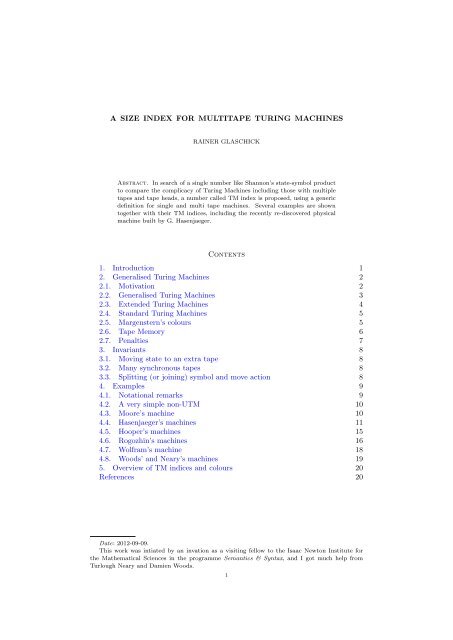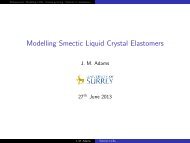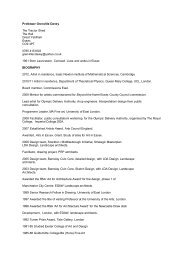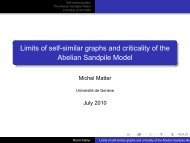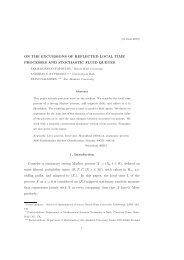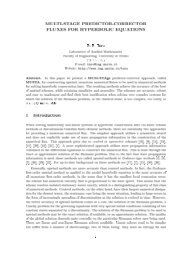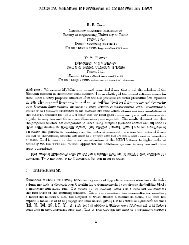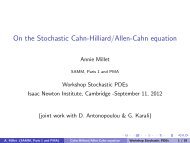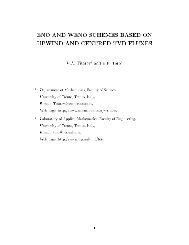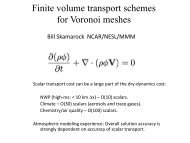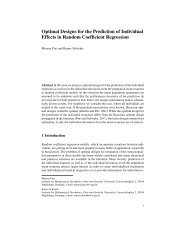A Size Index for Multitape Turing Machines - Isaac Newton Institute ...
A Size Index for Multitape Turing Machines - Isaac Newton Institute ...
A Size Index for Multitape Turing Machines - Isaac Newton Institute ...
Create successful ePaper yourself
Turn your PDF publications into a flip-book with our unique Google optimized e-Paper software.
A SIZE INDEX FOR MULTITAPE TURING MACHINES<br />
RAINER GLASCHICK<br />
Abstract. In search of a single number like Shannon’s state-symbol product<br />
to compare the complicacy of <strong>Turing</strong> <strong>Machines</strong> including those with multiple<br />
tapes and tape heads, a number called TM index is proposed, using a generic<br />
definition <strong>for</strong> single and multi tape machines. Several examples are shown<br />
together with their TM indices, including the recently re-discovered physical<br />
machine built by G. Hasenjaeger.<br />
Contents<br />
1. Introduction 1<br />
2. Generalised <strong>Turing</strong> <strong>Machines</strong> 2<br />
2.1. Motivation 2<br />
2.2. Generalised <strong>Turing</strong> <strong>Machines</strong> 3<br />
2.3. Extended <strong>Turing</strong> <strong>Machines</strong> 4<br />
2.4. Standard <strong>Turing</strong> <strong>Machines</strong> 5<br />
2.5. Margenstern’s colours 5<br />
2.6. Tape Memory 6<br />
2.7. Penalties 7<br />
3. Invariants 8<br />
3.1. Moving state to an extra tape 8<br />
3.2. Many synchronous tapes 8<br />
3.3. Splitting (or joining) symbol and move action 8<br />
4. Examples 9<br />
4.1. Notational remarks 9<br />
4.2. A very simple non-UTM 10<br />
4.3. Moore’s machine 10<br />
4.4. Hasenjaeger’s machines 11<br />
4.5. Hooper’s machines 15<br />
4.6. Rogozhin’s machines 16<br />
4.7. Wolfram’s machine 18<br />
4.8. Woods’ and Neary’s machines 19<br />
5. Overview of TM indices and colours 20<br />
References 20<br />
Date: 2012-09-09.<br />
This work was intiated by an invation as a visiting fellow to the <strong>Isaac</strong> <strong>Newton</strong> <strong>Institute</strong> <strong>for</strong><br />
the Mathematical Sciences in the programme Semantics & Syntax, and I got much help from<br />
Turlough Neary and Damien Woods.<br />
1
2 RAINER GLASCHICK<br />
1. Introduction<br />
When the Heinz Nixdorf MuseumsForum 1 searched <strong>for</strong> objects to be presented<br />
during the Alan <strong>Turing</strong> year, a physical model of a <strong>Turing</strong> machine built by Gisbert<br />
Hasenjaeger was located by its director Norbert Ryska. Unlike some other physical<br />
models, Hasenjaeger’s machine is not only a curiosity, but has also an interesting<br />
theoretical background. Searching <strong>for</strong> the relevance of this machine, the starting<br />
point was Shannon’s state-symbol product, as he wrote in [Shannon1956]: An interesting<br />
unsolved problem is to find the minimum possible state-symbol product <strong>for</strong><br />
a universal <strong>Turing</strong> machine. Having only four states and three binary tapes, giving<br />
the very small state-symbol product of eight, this would indicate an unnoticed milestone.<br />
But with the use of more than one tape, Shannon’s state-symbol product<br />
looses its significance, see e.g. [Hooper1969].<br />
Nevertheless, a single number to indicate the complicacy of a <strong>Turing</strong> Machine<br />
with more than one tape or more heads would be nice indicator <strong>for</strong> a ranking,<br />
although it is clear that such a ranking cannot replace an in-depth analysis.<br />
Hooper proposed the number m · n p <strong>for</strong> a machine with m states, n symbols<br />
(including blank and end marker) and p tapes, which is equal to the state-symbol<br />
product <strong>for</strong> a single tape machine. However, this number implies that the tapes are<br />
all of the same kind, i.e. all provide all operations, have the same alphabet, etc.<br />
Hooper used further in his article the triple (m, n, p) to characterise the machines,<br />
not the single number obtained from his <strong>for</strong>mula.<br />
In his German text, [Priese1979a] uses two-dimensional tapes and gives three<br />
complexity types:<br />
• a quadruple (z, b, d, k), where z is the number of states, b the number of<br />
symbols, d the number of tape dimensions, and k the number of heads or<br />
tapes<br />
• Hooper’s number, i.e. z · b k<br />
• the number of possible instructions, basically (z · b k · 2d) z·bk<br />
In his English paper [Priese1979b], only the third number, called complexity, is<br />
used. However, this number is not only very large, so the logarithm is used; it<br />
more or less characterises a class of machines, and, like Hooper, does not take into<br />
account if tapes are non-erasable, cyclic etc.<br />
In their 2009 paper [NearyW2009], Neary and Woods give an excellent overview<br />
of small universal TMs in general, and concentrate on weakly universal ones in<br />
particular, all as single tape machines.<br />
Margenstern [Margenstern1993] uses colours to characterize <strong>Turing</strong> <strong>Machines</strong><br />
with a single tape, and cites Pavlotskaia to prove that a minimum number of colours<br />
is necessary <strong>for</strong> a machine to be universal.<br />
This text gives a (not novel) definition <strong>for</strong> a <strong>Turing</strong> Machine, here called generalised<br />
TM, which embraces TMs with one or more tapes in a single model, and<br />
defines a size indicator <strong>for</strong> it, called TM index, that is<br />
• equal to Shannon’s state-symbol product <strong>for</strong> standard single-tape TMs,<br />
• is invariant <strong>for</strong> two trans<strong>for</strong>mations intuitively considered irrelevant,<br />
• gives smaller numbers <strong>for</strong> restricted machines (non-erasable, weakly universalS)<br />
Comparing the TM index is logical only <strong>for</strong> machines that serve the same task,<br />
and <strong>for</strong> universal <strong>Turing</strong> machines in particular.<br />
Multihead and multitape machines that were introduced and used in the discussion<br />
of computational complexity by Hartmanis and Stearns [HartmanisS1965] are<br />
likewise covered, but not with examples, see also [JiangSV1997].<br />
1 in Paderborn, Germany: http://www.hnf.de/
A SIZE INDEX FOR MULTITAPE TURING MACHINES 3<br />
It has been observed that reducing the state-symbol product <strong>for</strong> TMs often<br />
• increases the computational complexity in time and space,<br />
• requires extra ef<strong>for</strong>t to encode and decode the tape contents,<br />
• makes it difficult to determine that the machine stopped.<br />
In particular the complexity issues are not contained in this text, <strong>for</strong> these, see<br />
e.g. [WoodsN2009].<br />
Throughout the text, the abbreviation TM is used <strong>for</strong> <strong>Turing</strong> Machine, UTM <strong>for</strong><br />
Universal <strong>Turing</strong> Machine, gTM <strong>for</strong> generalised <strong>Turing</strong> Machine, sTM <strong>for</strong> standard<br />
<strong>Turing</strong> Machine, and xTM <strong>for</strong> extended <strong>Turing</strong> Machine.<br />
2. Generalised <strong>Turing</strong> <strong>Machines</strong><br />
2.1. Motivation. Looking at various variants of (deterministic) <strong>Turing</strong> <strong>Machines</strong>,<br />
they all have in common a finite state machine, that sends symbols and action<br />
commands to an unlimited deterministic memory, and in return receives a symbol<br />
that is used to advance the finite state machine; see also [Fischer1965a] 2 .<br />
This definition of a generalised TM could be regarded as a template or class of<br />
TMs, as it does not require a specific memory.<br />
Note that several definitions of a TM do not <strong>for</strong>mally define the tape memory.<br />
The tape is often introduced by its inscriptions, and the changes to the inscriptions<br />
are mostly explained just verbally. One could have the impression that TMs are<br />
just finite state machines, and miss the specialty of the tape memory.<br />
The attribute generalised is used to distinguish from a standard TM, that has a<br />
single tape without restrictions and in each state writes to the tape and moves the<br />
tape during a single state transition 3 .<br />
2.2. Generalised <strong>Turing</strong> <strong>Machines</strong>. An generalised <strong>Turing</strong> Machine (gTM) is<br />
a finite state organ Σ connected to an unlimited memory organ Ψ, both having an<br />
input and an output each, such that the output of the memory Ψ is an input to<br />
the state organ Σ, and its output is an input to the memory.<br />
2.2.1. The finite state subsystem. The finite state subsystem Σ is a deterministic<br />
finite state machine described by the sixtuple (S, I, Ψ, σ, s0, s1) with:<br />
• a finite set of states S = s0, s1, s2, . . .,<br />
• a finite input alphabet I = i1, i2, . . .,<br />
• a finite action alphabet Ψ = ψ1, ψ2, . . .,<br />
• a state stepping (partial) map σ : (S − {s0}) × I → Ψ × S<br />
The state s1 is called the start state, and the state s0 the stop state, thus there<br />
must not be a step defined <strong>for</strong> it.<br />
The action alphabet embraces the symbols written as well as the movement of<br />
the tape, thus it is different from the input alphabet. This does not exclude that<br />
the input symbols as well as the actions may be n-tuples; e.g. <strong>for</strong> a 3-tape machine,<br />
the input symbols might be triples and the actions sextuples; see below <strong>for</strong> the<br />
extended TM. The only restriction is that the memory subsystem does understand<br />
the action symbols and produces input symbols <strong>for</strong> the state machine.<br />
Two-dimensional tapes as in [Priese1979a, Priese1979b] fit perfectly in the above<br />
definition: if the tapes are binary, the input alphabet has two members, but the<br />
action alphabet has eight instead of four (up and down as well as right and left <strong>for</strong><br />
2 Cooper in his Computability Theory [Cooper2003] uses this same model in his definition of a<br />
TM, i.e. provides separate actions <strong>for</strong> writing and movement, but does not extend his model to<br />
multi-tape machines.<br />
3 This is what has become standard now; <strong>Turing</strong>’s machine definition allows several actions<br />
combined in one state transition to avoid states with less significance to understanding the function<br />
of the machine.
4 RAINER GLASCHICK<br />
each input symbol), probably as pairs with the symbols to be written. Multihead<br />
TMs must keep more state in the memory subsystem.<br />
The stepping map need not be a total function; there may be undefined input<br />
combinations, often because they will never occur. See the next section on stop<br />
states.<br />
Being defined on finite sets, the stepping map is normally described by some sort<br />
of table or matrix; here, a table with four columns will be used: The first two give<br />
the current state and input element, the last two the action and the next state.<br />
2.2.2. The stop state. In this definition, a stop state is stipulated 4 .<br />
Several TM definitions declare the stop of the machine when σ is undefined <strong>for</strong><br />
the current state and input symbol, or they do not show the stop state in the state<br />
table, but have a remark in the text. In these cases, often only the missing line in<br />
the state table has to be added, as has been done in some of the examples below.<br />
When the stop state is reached, the action output symbol is arbitrary and not sent<br />
to the memory, thus any one could be used; this may be indicated by dashes in the<br />
state tables, that are not counted as actions.<br />
For other TMs, the stop state is equivalent to a certain cycle of states. This<br />
cycle should be at least detectable by a FSM. Then, its states have to be counted<br />
too, unless a simple extension of the state machine would do.<br />
2.2.3. The memory subsystem. The memory is an unlimited deterministic subsystem<br />
using the same sets as the state machine <strong>for</strong> S, I and Ψ, described by the<br />
sixtuple (T, r, w, S, I, Ψ) with:<br />
• a (unlimited) set of states T = t1, t2, . . .<br />
• a read function r : T → I to read the current symbol of the tape state<br />
• a write function w : T × Ψ → T to write, i.e. execute an action and return<br />
a new tape state<br />
The first memory state t1 is called the initial memory contents.<br />
2.2.4. The combination is the gSM. Combining the state machine and the memory,<br />
a generalised <strong>Turing</strong> Machine is thus described by the tuple:<br />
(S, I, Ψ, σ, s0, s1, T, r, w)<br />
Note that the initial memory contents t1 is not included, in order to allow the<br />
application of a single machine to different initial memory contents.<br />
So the application of a gTM to an initial memory contents t1 generates a list of<br />
quadruples (sj, tj, ij, ψj) with (<strong>for</strong> j > 0 until sj+1 = s0):<br />
ij = r(tj)<br />
(sj+1, ψj) = σ(sj, ij)<br />
ij+1 = w(tj, ψj)<br />
The symbols ij and ψj are redundant and were used <strong>for</strong> clarity.<br />
4 Alan <strong>Turing</strong>’s definition <strong>for</strong> computable numbers uses cycle-free machines, that are running<br />
<strong>for</strong>ever without going into cycles, i.e. repeating a pattern periodically on the tape, as compared<br />
to machines used <strong>for</strong> the solution of the Entscheidungsproblem.
A SIZE INDEX FOR MULTITAPE TURING MACHINES 5<br />
2.2.5. The TM index. The generalised TM state table complicacy index, or TM<br />
index <strong>for</strong> short, is defined as a single number by<br />
�<br />
|I| · |Ψ|<br />
|S| ·<br />
2<br />
For a standard TM with one erasable tape, it is equal to the state-symbol product,<br />
see below. For the product |I| · |Ψ|, the term symbol state area size or simply<br />
IO size might be used, and <strong>for</strong> the whole term after the state count the term symbol<br />
equivalent.<br />
This index, as it uses the cardinality of Ψ, thus depends on which actions are<br />
possible on the memory (i.e. if tapes move in only one direction) and the number<br />
of symbols that could be written (i.e. <strong>for</strong> non-erasable or read-only memory), and<br />
thus reflects characteristics from the memory subsystem.<br />
This, however, does not honor every quirk in the memory subsystem, see 2.6.6<br />
on penalties. In this case, we call the TM index without penalties the basic TM<br />
index.<br />
2.3. Extended <strong>Turing</strong> <strong>Machines</strong>. A extended <strong>Turing</strong> Machine (xTM) is a special<br />
case of the generalised TM, which differentiates the output symbols and the<br />
tape movements, using a subset of the input symbols as output symbols.<br />
Here, the action symbols are pairs of elements from a set O of state output<br />
symbols and a set Ξ of memory instructions. Naturally, the memory subsystem<br />
now must accept these pairs.<br />
The set O of symbols output to the memory is taken from the input symbols,<br />
but needs not to cover them all. This allows to express directly that symbols on<br />
the tape are only present in the initial tape inscription, and are never written. A<br />
new set of memory instructions Ξ is introduced, and the extended TM is a gTM<br />
with the tuple (S, I, Ψ, σ, s0, s1, T, r, w), having:<br />
• the output symbol set O ⊆ I<br />
• the memory instructions Ξ = {ξ1, ξ2, . . .}<br />
• where the memory actions are Ψ ⊆ O × Ξ<br />
• and the memory write function is w : T × (O × Ξ) → T<br />
Note that the expression<br />
�<br />
|I| · |O| · |Ξ|<br />
|S| ·<br />
2<br />
is only equal to the gTM index, if Ψ = O × Ξ, i.e. if all combinations of output<br />
symbols and instructions are used as memory actions.<br />
Note that because the set of output symbols O may be a subset of the input<br />
symbols I, this allows to express characteristics of non-erasing machines and weak<br />
machines already in the state machine, and not only as (mostly verbal) restrictions<br />
of the memory subsystem.<br />
Note also, that the input and output symbols as well as the memory instructions<br />
might still be (sub-) tuples, (e.g pairs <strong>for</strong> two tapes).<br />
The extended TM will not be used in the examples, because it looks not suitable<br />
to define a useful index.<br />
2.4. Standard <strong>Turing</strong> <strong>Machines</strong>. The standard TM is an xTM, where:<br />
• the set of output symbols is equal to the input symbols: I = O<br />
• the set of movement operations has two members Ξ = {R, L}<br />
Thus, the TM index becomes, because |Ξ| = 2:<br />
�<br />
|Y | · |Y | · |Ξ|<br />
|S| ·<br />
2
6 RAINER GLASCHICK<br />
�<br />
|Y | · |Y | · 2<br />
= |S| ·<br />
2<br />
= |S| · |Y |<br />
which is equal to Shannon’s state-symbol product.<br />
For binary machines, there are only 4 action symbols possible, and these are<br />
normally all used, if it is a standard TM, even though only two of them can be used<br />
per state. This allows all 4 action symbols if the machine has more than 2 states,<br />
which has been proved to be necessary anyhow. For a non-erasing binary machine,<br />
there may be still 4 actions, so there are 4 · 2 possible combinations of actions and<br />
input symbols per state.<br />
As the examples below show, rather often single tape TMs with many symbols<br />
do not use all combinations, so that in these cases the TM index is smaller than<br />
the state-symbol product, which might be surprising first, but indicates that the<br />
memory has to be less complex than <strong>for</strong> a full TM.<br />
2.5. Margenstern’s colours. For a standard TM, Margenstern introduces in<br />
[Margenstern1993] the colours of an instruction as the combination of the input<br />
symbol and action, i.e. output and movement operation <strong>for</strong> a gTM. It is possible<br />
to look at the set of colours per state and per machine. The maximum numbers<br />
of colours per state is |I| · |O| · 2 = |I| 2 · 2, as any input can be combined with<br />
any output with one out of two movements, and input symbols are the same as<br />
output symbols <strong>for</strong> a standard TM. The set of colors per machine then contains the<br />
colours of all instructions of all states. However, it seems to be of limited value <strong>for</strong><br />
an index number, because it is limited by the above number, even <strong>for</strong> many states.<br />
(If a single state uses up all colours, no other state can add new colours). If follows<br />
that the number of colours of a binary machine is 8 at most. (Astonishingly, the<br />
set of colours <strong>for</strong> a machine is often less than the maximum.)<br />
Instead, the sum of the number of colours per state could be used, which is not<br />
greater than the product |I| × |Ψ|, the IO size of an gTM. So it might be more<br />
specific, but might not be invariant to some trans<strong>for</strong>mations, as it heavily depends<br />
on the distribution of colours versus states.<br />
It would be interesting to analyze the Theorems given by [Margenstern1993]<br />
(some of which were found by Pavlotskaia), if they could be applied to the TM<br />
index, but this is outside the scope of this work.<br />
2.6. Tape Memory. No attempt will be made to expand the examples by proper<br />
tape memory definitions, only some illustrations are shown <strong>for</strong> standard TMs. Note<br />
that the position of the read-write head must be recorded in the state of the memory.<br />
It would be desirable to have something like the TM index <strong>for</strong> the state machine<br />
<strong>for</strong> the memory system, in order to reflect the complicacy of the memory. However,<br />
the tape memory is regarded not only as fairly simple in its structure, but there<br />
are only a few varieties, that can serve a much larger number of state machines.<br />
Also, several of the specialties of the tape memory can be cared <strong>for</strong> in the gTM<br />
definition and state table analysis, except e.g. cyclic tapes. Thus, such an attempt<br />
is not tried here.<br />
2.6.1. Tape memory as a n-tuple. A fairly simple and flexible memory <strong>for</strong> a standard<br />
TM uses a n-tuple <strong>for</strong> the tape contents (except the still blank part), and an<br />
integral number as an index into to the n-tuple as location <strong>for</strong> the tape head.<br />
Using n = |(x1, . . . , xn)| <strong>for</strong> the number of elements in the n-tuple (x1, . . . , xn),<br />
and defining the auxiliary functions κ, λ and ζ, we could model the tape state as a<br />
set (or pair) of a natural number and an n-tuple of input symbols:<br />
tj = {kj, (ij,1, ij,2, . . . ij,kj−1, ij,kj , . . . ij,lj )}
A SIZE INDEX FOR MULTITAPE TURING MACHINES 7<br />
1 ≤ kj ≤ lj<br />
κ(tj) = kj<br />
λ(tj) = lj = |(ij,1, ij,2, . . . ij,kj−1, ij,kj , . . . ij,lj )|<br />
∀x ≤ lj : ζ(tj, x) = ij,x<br />
The read function is just:<br />
r(tj) = ζ(tj, κ(tj))<br />
For the write function, the action symbol is a pair (y, z) where y ∈ O ⊆ I and<br />
z ∈ {R, L} and the new state depends on the values of z and kj = κ(tj) as follows,<br />
where lj = λ(tj):<br />
• z = R, kj �= lj: w(tj, (y, z)) = {kj+1, (ij,1, ij,2, . . . ij,kj−1, y, ij,kj+1, . . . ij,lj )}<br />
• z = R, kj = lj: w(tj, (y, z)) = {Skj + 1, (ij,1, ij,2, . . . ij,kj−1, y, y0)}<br />
• z = L, kj �= 1: w(tj, (y, z)) = {kj − 1, (ij,1, . . . , ij,kj−1, y, . . . , ij,lj )}<br />
• z = L, kj = 1: w(tj, (y, z)) = {1, (y0, y, ij,2, . . . , ij,lj )}<br />
where y0 is the blank symbol. A blank tape is then t1 = {1, (y0)} with κ(t1) = 1,<br />
so the first operation extends it to two elements.<br />
This scheme extends easily to multi-tape machines and multi-dimensional tapes.<br />
Cyclic tapes are also not difficult to integrate, as they have a fixed size and thus the<br />
n-tuple with the contents is initially predefined and does not change, and the tape<br />
position is taken modulo this size. Non-erasing tapes just require more conditions on<br />
the function, and are sufficiently characterized by less actions in the gTM definition.<br />
2.6.2. Tape memory as string. The single tape memory used in the standard TM<br />
could be described as as a symbol chain or string, using an extra symbol not in the<br />
input-output-symbol to note the position of the read-write-head. This is often the<br />
state number, in which case the set of symbols and states must be distinct.<br />
2.6.3. Tape memory as two pushdown stores. Tape memory is a pair of symbol<br />
strings, i.e. n-tuples of input symbols, plus the current symbol, the strings constituting<br />
the parts left and right to the head.<br />
2.6.4. Tape memory as fixed mapping from integer numbers to symbols. The tape<br />
contents is a mapping m : Z → S from integer numbers to symbols, and the state<br />
is the pair (sj, mj), see [Boerger1985]. It is presumed that the domain of mj, i.e.<br />
the smallest and largest number <strong>for</strong> the memory state used so far, needs not be<br />
tracked explicitly, but can be efficiently determined from the mapping itself.<br />
2.6.5. Tape memory as gliding mapping integer numbers. The tape state is a mapping<br />
m(i, y) : Z → Y from integer numbers to symbols, where the symbol <strong>for</strong> zero<br />
is the current position of the head. As the tape head is always mapped from zero,<br />
there is no need to keep it besides the mapping. However, realisation of a mapping<br />
requires a table <strong>for</strong> each state, and thus doubles the size to save a single index.<br />
2.6.6. Restricted tapes. In many cases, tapes are restricted:<br />
• they can only move in one direction<br />
• they do not move at all<br />
• the tapes are read-only, i.e. the initial inscription is never changed<br />
• a symbol may not be erased<br />
• the symbols constitute an ordered graph with respect to writing, (which is<br />
a generalisation of a non-erasable tape)<br />
• the tapes are cyclic (if read-only)<br />
• the tapes are infinitely prefilled with patterns<br />
Except the last ones, these conditions have an influence in the TM index because<br />
fewer operations are provided.
8 RAINER GLASCHICK<br />
2.7. Penalties. In case the TMs have some quirks that allow fewer states by leaving<br />
out features that the others have, e.g. a missing stop state or requiring a cyclic<br />
tape, penalties may correct <strong>for</strong> these cases. However, penalties depend on human<br />
judgement and thus are estimates. The following rules are applied in the examples:<br />
If one of the tapes is cyclic and read-only, i.e. has a single infinitely repeated<br />
pattern, this saves at least one action and thus reduces the TM index. Maybe it<br />
also increases the computational complexity, but this is not taken into account in<br />
the TM index. Thus, a penalty of one extra operation to compensate <strong>for</strong> the saved<br />
move in the other direction could be applied.<br />
If the tape is infinite, but not filled with blanks, but with a repeating pattern<br />
outside the encoding of the guest machine, this is regarded more complicated than<br />
a cyclic tape, and thus an action penalty of two is used.<br />
If the tape is not only infinite, but also filled with a pattern that is not repeating,<br />
an action penalty of at least three is used.<br />
If there is no stop state easily added, some extra states may be added in the<br />
calculation. The number used should estimate the necessary ef<strong>for</strong>t to determine<br />
the stop situation. If the stop is a cycle of n states, a state penalty of n − 1 is<br />
used, as a coupled FSM to detect the cylcle would need n states. If the stop is not<br />
detected by a defined cycle, the state penalty becomes very large, if not infinite.<br />
At least, the number of states plus 1 will be used.<br />
Thus, using the state penalty PS and the operation penalty PΨ, the <strong>for</strong>mula <strong>for</strong><br />
the estimated TM index becomes:<br />
�<br />
|I| · (|Ψ| + PΨ)<br />
(|S| + PS) ·<br />
2<br />
3. Invariants<br />
Trans<strong>for</strong>mations on standard TMs and their influence on the state symbols product<br />
have been studied since Shannon, and as the TM index is the same, these need<br />
not to be evaluated here.<br />
So here the emphasis is on changes in the number and characteristics of more<br />
than one tape. For these, some machine trans<strong>for</strong>mations can be given that do not<br />
alter the TM index.<br />
3.1. Moving state to an extra tape. Shannon proved that with only one tape,<br />
a 1-state standard UTM is not possible.<br />
If a second tape is allowed, a machine with only 1 state is fairly simple, using the<br />
technique used by Hooper in appendix II of [Hooper1969]. For a standard <strong>Turing</strong><br />
machine, just a second (changeable) tape is added, the number of symbols on this<br />
tape being equal to the number of states. This second tape is never moved, it just<br />
serves to replace the states.<br />
The trans<strong>for</strong>mation of any n-state m-symbol 1-tape machine with the common<br />
two operations is simple: Just use the pairs of the m symbols and n states as inputs,<br />
giving m · n new input symbols, and write the new state to second tape, i.e. use<br />
pairs of new state and new symbol as actions, i.e. m · 2 · n actions. The TM index<br />
� m·m·2<br />
2<br />
� (n·m)·(m·2·n)<br />
was n · be<strong>for</strong>e and is 1 ·<br />
2 thereafter, thus is equal under this<br />
trans<strong>for</strong>mation. Hence, using the square root is essential.<br />
3.2. Many synchronous tapes. Any n-state, m-symbol, 1-tape TM can be simply<br />
trans<strong>for</strong>med to a n-state, 2-symbol, multitape machine, using either unary or<br />
binary representation. All tapes are moved the same each time.<br />
If unary representation is used, m tapes are required, the symbols are represented<br />
by a bit on one of the m tapes only.
A SIZE INDEX FOR MULTITAPE TURING MACHINES 9<br />
Although m tapes with 2 symbols each span an input space of size 2 m , only m<br />
of these are used. Similarily, there are still only 2 · m actions, thus the symbol state<br />
area size is still n · m · 2 · m · n, and the TM index is unchanged.<br />
If binary representation is chosen, k tapes are required such that 2 k > m The m<br />
symbols are binary coded. As only the used symbols and actions are counted, the<br />
TM index is still the same.<br />
3.3. Splitting (or joining) symbol and move action. A case that might at<br />
the first glance be counter intuitive is the splitting of actions, because one might<br />
demand that this operation, that does not change the net behavior, should keep<br />
the TM index invariant.<br />
For a standard TM, it is redundant to have a no move, just change action,<br />
because this action could then be replaced by that of the target state 5 . An engineer<br />
might argue technically, that the symbol change and the tape movement have to be<br />
done sequentially anyhow, as the tape can only be moved once the symbol write has<br />
finished. So he might propose a TM, where the action set does not contain the four<br />
members: {0R, 0L, 1R, 1L}, but instead use the action set {0, 1, R, L} i.e. either<br />
move or change symbol. Because every state of the original TM would have to be<br />
split into two states, there would be twice the number of states and thus the TM<br />
index double. The engineer should, however, come to the conclusion that it would<br />
normally be less ef<strong>for</strong>t to have a three-phase clock instead of a two-phase clock,<br />
speeding up the machine by the factor 4/3 and using half the number of memory<br />
cells <strong>for</strong> the state memory. Thus, the increase in the TM index is finally sensible,<br />
at least if used as an indicator <strong>for</strong> the technical ef<strong>for</strong>t.<br />
With multitape TMs, the picture is different. For the human it is much easier<br />
to understand a state table, when just one tape is moved at a time. Whether e.g.<br />
the examples below can be optimized (regarded as gTMs), and if this can be done<br />
by a general algorithm, has not yet been explored.<br />
4. Examples<br />
Several TMs are discussed, and the results summarized in Table 1. Some standard<br />
TMs are included <strong>for</strong> comparison.<br />
4.1. Notational remarks. State tables are written down using four columns, as<br />
indicated above:<br />
• actual state number<br />
• input symbols<br />
• action symbols<br />
• next state number<br />
It is assumed that input symbols are mapped to a single character per tape,<br />
which is possible in the cases given. If the machine has more than one tape, the<br />
input symbol column thus has two or more characters that represent the symbols<br />
on the tapes.<br />
For the action symbols, it depends on the machine if there is a single character<br />
used <strong>for</strong> writing symbol or moving the tape, or two characters <strong>for</strong> writing a symbols,<br />
and moving the tape afterwords. In the latter case, five columns may be used, where<br />
the colums <strong>for</strong> the output symbol and the tape movement could be seen as joined<br />
to a single column if seen as an gTM. The hyphen character is used as symbol <strong>for</strong><br />
no action.<br />
In order to increase human readability, dots are used in the tables as follows:<br />
5 except <strong>for</strong> the stop state, see examples
10 RAINER GLASCHICK<br />
In the input column, they denote that the input symbol may be any of those<br />
on the tape, and the state table line in fact represents as many lines as there are<br />
symbols <strong>for</strong> the dot. This implies that <strong>for</strong> each dot, all the symbols to be generated<br />
are explicitly used in at least one other line.<br />
In the output column, the meaning of the dot is same symbol as input.<br />
E.g., Hasenjaeger’s machine could either move or punch on the R-tape, because<br />
the Wang instructions are like this, including the option not to move or punch,<br />
which is represented by -. On Hooper’s machine, a pair is given of the new symbol<br />
— which may be the same — and the tape move including no move, explicitly<br />
denoted by -.<br />
Dots in the last column simply mean keep that state.<br />
From a mathematical point of view, there is no difference whether a symbol on<br />
a tape is replaced by itself (output) or nothing done; from a technical point of view<br />
the latter mostly means significantly less circuitry, but it can be easily detected and<br />
is noted here by dots just <strong>for</strong> readability. For counting the numbers to calculate<br />
the TM index, dots are resolved to the respective values.<br />
The condition that tapes are presumed to be cyclic is not noted in the state<br />
tables directly, as are other restrictions.<br />
Note that <strong>for</strong> calculating the TM index, it is irrelevant if e.g. the operations are<br />
noted with two characters, like 0R, 0L, 1R and 1L or four different single characters,<br />
as long as it is used consistently. We just need to expand the dots and count the<br />
number of different input conditions and the number of different actions.<br />
It would have been a nice exercise to trans<strong>for</strong>m each non-binary TM to a binary<br />
TM and calculate the TM index, optionally doing some optimizations.<br />
Please keep in mind that the issues of computational complexity and the ef<strong>for</strong>t<br />
of encoding and decoding are not covered by the TM index.<br />
4.2. A very simple non-UTM. Just to have a very simple TM, we give a (nonoptimal)<br />
state table <strong>for</strong> a non-universal binary TM that appends a mark at the end<br />
of a chain of marks:<br />
s in out s’<br />
1 M R 1<br />
1 b - 2<br />
2 b M 2<br />
2 M - 0<br />
It has two states, two input symbols b,M and three output actions R,M,- so the<br />
state-symbol product is 4, but the TM index is 2 · √ 3 = 3.46, because the L action<br />
is not used. The colour count is 4 instead of 6 <strong>for</strong> the same reason.<br />
4.3. Moore’s machine. This machine, published in [Moore1952], was perhaps the<br />
first multitape machine with a small number of states with a fully published state<br />
table. Also, Moore discussed the conditions to physically build such a machine and<br />
found it feasible, the largest problem being the erasable tape, as also observerd by<br />
Hasenjaeger, see [Hasenjaeger1987].<br />
The machine has 15 states and 3 tapes, one <strong>for</strong> the simulated machine, one<br />
non-erasable tape <strong>for</strong> remembering the next state, and one read-only unidirectional<br />
cyclic tape <strong>for</strong> the coded state table. The coding just writes four numbers <strong>for</strong> each<br />
state, using alternately inverted unary numbers 6 .<br />
The state table is (in the order used by Moore, without his extensive comments):<br />
S PQR PQR S’<br />
1 11. -R- 2<br />
6 2, 1, 3, 4 is encoded 1 2 , 0 1 , 1 3 , 0 4 , i.e. 1101110000
A SIZE INDEX FOR MULTITAPE TURING MACHINES 11<br />
2 1.. R-- 1<br />
1 10. -L- 3<br />
3 1.. R-- .<br />
3 01. -L- 4<br />
1 01. -L- 4<br />
4 01. -L- .<br />
4 00. R-- 5<br />
5 00. R-- .<br />
5 10. -R- 1<br />
1 00. -R- 6<br />
6 00. R-- 7<br />
7 10. --0 8<br />
7 00. R-- 9<br />
9 01. --1 8<br />
10 10. --L 8<br />
10 00. R-- 11<br />
11 10. --R 8<br />
8 100 -1- 13<br />
8 101 -1- 12<br />
12 111 -R- 15<br />
15 .0. -1- 13<br />
13 11. -R- 14<br />
14 10. R-- 15<br />
15 .0. -1- 13<br />
13 01. -L- 4<br />
As it has 3 tapes, it has 23 = 8 input symbols, which are covered by the state<br />
table. Only 8 actions are used <strong>for</strong> the tape, as only one tape is operated at a state<br />
transition. So the symbol equivalent is √ 32 = 5.7, giving a basic TM index of<br />
�<br />
8 · 8<br />
15 · = 84.9<br />
2<br />
For the cyclic tape, an action penalty of 1 used. There is no stop state; perhaps<br />
because the state number zero cannot be coded. If in the encoding of the state table<br />
a state number is used <strong>for</strong> which not definition exists, the machine will endlessly<br />
search that state number on the program tape. According to the rules given above,<br />
a state penalty of 14 has to be used, although a smaller solution might be possible.<br />
The estimated TM index is thus:<br />
�<br />
8 · (8 + 1)<br />
(15 + 14) ·<br />
= 174<br />
2<br />
4.4. Hasenjaeger’s machines. Hasenjaeger never published details himself, just<br />
some global remarks in [Hasenjaeger1987]; he just did build a physical machine he<br />
called the Mini-Wang. 7 According to his hand-written notes, he started the design<br />
in 1962 and did the schematics in 1963, thus his machine could be dated as of<br />
1964. No evidence is known today when the machine was ready <strong>for</strong> and used in<br />
demonstrations in seminars and lectures in Münster or Bonn.<br />
The binary encoding <strong>for</strong> Wang’s instructions used by Hasenjaeger is:<br />
• 1: mark tape<br />
• 01: move right<br />
• 001: move left<br />
7 He had build a larger machine of similar design be<strong>for</strong>e and called it the Wang machine,<br />
because Wang in [Wang1957] showed that a universal machine could be non-erasing.
12 RAINER GLASCHICK<br />
• 00 0 n 1: conditional skip n instructions<br />
Note that each instruction has exactly one marked bit, so the number of ones is<br />
the number of instructions to skip.<br />
4.4.1. The original machine with a bi-directional progamme tape. The (real) Hasenjaeger<br />
machine in its original <strong>for</strong>m <strong>for</strong> a bi-directional cyclic programme tape 8 and<br />
without stop state is:<br />
S PQR PQR S’<br />
I: P=1 is punch, P=0 other instruction<br />
1 1.0 R-M . mark if not marked, next instruction<br />
1 1.1 R-- . do not mark if marked, next instruction<br />
1 0.. R-- 2 other instruction, take the 0<br />
II: R, L or other; Q is zero on entry<br />
2 10. R-R 1 go right, next instruction<br />
2 00. RR- . save 0 in Q, check next P bit<br />
2 11. RLL 1 next P bit is 1, go left, clear Q, next inst.<br />
2 01. RL- 3 next P bit is 0, this is a skip<br />
III: skip part 1: count zeroes to Q, if mark<br />
3 0.0 R-- . R has space, skip zeroes until P=1<br />
3 1.0 R-- 1 R has space, end found: next instruction<br />
3 0.1 RR- . R has mark, count zeroes until P=1<br />
3 1.1 LR- 4 R has mark, end found: exec skip<br />
IV: skip part 2: execute<br />
4 01. L-- . while Q>0, skip zeroes on P, leave Q<br />
4 11. LL- . while Q>0, skip a one, decrement Q<br />
4 .0. R-- 1 Q=0, next instruction (mark prepended)<br />
It has four distinct states and three binary tapes, P, Q and R. Tape P is the<br />
programme tape with a defined initial inscription encoded as above, (using relative<br />
backward jumps only and a cyclic tape to achieve <strong>for</strong>ward jumps), and it is<br />
unchangeable. Tape Q is also unchangeable and has just a single mark, which is<br />
at the tape head position when the machine starts. Thus, tape Q can be used as<br />
a counter. Tape R is the working tape 9 <strong>for</strong> the simulated (guest) machine and not<br />
erasable.<br />
As there are three binary tapes, so it has 2 3 = 8 input combinations, which are<br />
all used and defined. The actions are:<br />
• -, R and L <strong>for</strong> tape P and tape Q<br />
• plus M <strong>for</strong> tape R.<br />
Thus, the maximum number of possible output actions is 3 ∗ 3 ∗ 4 = 36, but only<br />
9 of these are used, e.g. tape R is only � modified in three lines of the state table.<br />
8·9<br />
Thus, the symbol equivalent is 2 = √ 36 = 6.0 (incidently 3 · 2 <strong>for</strong> 3 tapes<br />
with 2 symbols), and the basic TM index is:<br />
�<br />
8 · 9<br />
4 · = 24.0<br />
2<br />
ignoring that there is no stop and that tape P is necessarily cyclic to allow<br />
conditional transfers to any instruction on tape P.<br />
8 build only recently from a bidirectional uniselector found in his legacy<br />
9 Rechenband in German, means calculating tape
A SIZE INDEX FOR MULTITAPE TURING MACHINES 13<br />
To replace tape P by a not-cyclic one is not trivial, thus a penalty of one action<br />
is used, giving an estimated TM index of:<br />
�<br />
8 · (10 + 1)<br />
4 ·<br />
= 26.5<br />
2<br />
As regards the missing stop state, Hasenjaeger in his private notes refers to what<br />
he calls a dynamic stop, i.e. using a conditional skip 0, i.e. jump back just to the<br />
same instruction. This means that tape R does not act, and tape P stays within a<br />
small section of the tape, and the relay pattern repeats each 10 clocks, which is not<br />
easy to detect. Using the above penalty rules, that would mean a state penalty of<br />
3, giving an estimated TM index of:<br />
�<br />
8 · (9 + 1)<br />
(4 + 3) ·<br />
= 44.27<br />
2<br />
It is, however, easy to detect a skip 0 by splitting the last line of state 3 as<br />
follows:<br />
3 111 LR- 4 end found; R has mark, need to skip<br />
3 101 --- 0 skip 0 is stop<br />
in which case no state penalty is necessary. However, the current hardware can<br />
sense tape R only in state 1 and 3, and tape Q only in state 2 and 4, so this requires<br />
a changed hardware. Another option could be to treat marking a marked state as<br />
a stop. But the conditional backward jump spaces one too far and lands on the<br />
mark that terminates an instruction, which has no effect, as tape R is on a mark<br />
anyhow, but requires that the mark on a marked tape does not stop.<br />
Thus, excluding the engineering aspect, only the penalty <strong>for</strong> the cyclic tape P is<br />
needed, giving an estimated TM index of 26.5.<br />
4.4.2. The modified machine with a uni-directional progamme tape. When the machine<br />
was found, there was no documentation available and a unidirectional programme<br />
tape enclosed, which did not fit to the state table. Looking <strong>for</strong> a way to<br />
have this configuration running, using <strong>for</strong>ward jumps seemed to be the solution,<br />
requiring only a small change in the state table, namely inverting a relay contact:<br />
S PQR PQR S’<br />
I: P=1 is punch, P=0 other instruction<br />
1 1.0 R-M . mark if not marked, next instruction<br />
1 1.1 R-- . no need to mark if marked, next instruction<br />
1 0.. R-- 2 other instruction, take the 0<br />
II: R, L or other; Q is zero on entry<br />
2 10. R-R 1 go right, next instruction<br />
2 00. RR- . save 0 in Q, check next P bit<br />
2 11. RLL 1 next P bit is 1, go left, clear Q, next inst.<br />
2 01. RL- 3 next P bit is 0, this is a skip<br />
III: skip part 1: count zeroes to Q, if mark<br />
3 0.0 R-- . R has space, skip zeroes until P=1<br />
3 1.0 R-- 1 R has space, end found: next instruction<br />
3 0.1 RR- . R has mark, count zeroes until P=1<br />
3 1.1 RR- 4 R has mark, end found: need to skip<br />
IV: skip part 2: execute<br />
4 01. R-- . while Q>0, skip zeroes on P, leave Q<br />
4 11. RL- . while Q>0, skip a one, decrement Q
14 RAINER GLASCHICK<br />
4 .0. --- 1 Q=0, next instruction<br />
Just the direction of skipping is changed from backwards to <strong>for</strong>wards, and using<br />
the cyclicity of the tape <strong>for</strong> backward jumps. However, this slows down the execution,<br />
as actions like skipping over a string of marks each time cycle the P-tape,<br />
making demonstrations nearly incomprehensible. Also, the dynamic stop is hard<br />
to see, but could be done as be<strong>for</strong>e, though not in the physical machine:<br />
3 111 RR- 4 R has mark, end found: need to skip<br />
3 101 --- 0 R has mark, end found, stop<br />
Because tape P has one action less, the machine has two less, thus the basic TM<br />
index is<br />
�<br />
6 · 7<br />
4 · = 21.2<br />
2<br />
Adding the penalty <strong>for</strong> the cyclicity of tape P, gives an estimated TM index of:<br />
�<br />
8 · (7 + 1)<br />
4 ·<br />
= 22.6<br />
2<br />
4.4.3. The compact machine. As I observed only recently, in state 2 of the above<br />
machine tables, tape Q is used as auxiliary state memory (similar to Hooper).<br />
Taking this further on, one state may be saved:<br />
S PQR PQR S’<br />
1 100 R-M .<br />
I: P=1 is punch, Q is zero on entry<br />
mark while not marked, next instruction<br />
1 101 R-- 0 if already marked, stop<br />
1 00. RR- . save 0 in Q, change to alternate state<br />
1 11. RLR . was 01: R, next instruction<br />
1 01. RL- 2 consumed two zeros, continue decoding<br />
II: L or Jump; Q is zero on entry<br />
2 10. R-L 1 was 001: L, next instruction<br />
2 00. RR- . bias Q, change to alternate state<br />
2 010 R-- . R has space, no jump, skip zeroes<br />
2 110 RL- 1 R has space, no jump, done<br />
2 011 RR- . R has mark, jump, count number of zeros<br />
2 111 L-- 3 end of jump instruction, execute jump<br />
III: execute jump<br />
3 01. L-- . skip zeros backwards<br />
3 11. LL- . skip back and count instruction<br />
3 00. R-- . Q zero, be<strong>for</strong>e end of next instruction<br />
3 10. R-- 1 Q zero, continue with next instruction<br />
It uses tape P bidirectional, and there are 8 input symbols and 8 output actions,<br />
giving a symbol equivalent of 5.7. With with only 3 states the basic TM index is:<br />
�<br />
8 · 8<br />
3 · = 17.0<br />
2<br />
This machine stops if an already marked place has to be marked, which is possible<br />
here. Although this increases the ef<strong>for</strong>t <strong>for</strong> some trans<strong>for</strong>mations from standard<br />
TMs to Wang-Hasenjaeger TMs, here the goal is to have a low TM index. Just one<br />
action penalty <strong>for</strong> the cyclic tape gives an estimated TM index of:<br />
�<br />
8 · (8 + 1)<br />
3 ·<br />
= 18.0<br />
2
A SIZE INDEX FOR MULTITAPE TURING MACHINES 15<br />
If a unidirectional tape P is used, this saves two actions:<br />
S PQR PQR S’<br />
1 100 R-M .<br />
I: P=1 is punch, Q is zero on entry<br />
mark while not marked, next instruction<br />
1 101 R-- 0 if already marked, stop<br />
1 00. RR- . save 0 in Q, change to alternate state<br />
1 11. RLR . was 01: R, next instruction<br />
1 01. RL- 2 consumed two zeros, continue decoding<br />
II: L or Jump; Q is zero on entry<br />
2 10. R-L 1 was 001: L, next instruction<br />
2 00. RR- . bias Q, change to alternate state<br />
2 010 R-- . R has space, no jump, skip zeroes<br />
2 110 RL- 1 R has space, no jump, done<br />
2 011 RR- . R has mark: count number of zeros<br />
2 111 R-- 3 end of jump instruction, execute jump<br />
III: execute jump<br />
3 01. R-- . skip zeros<br />
3 11. RL- . skip mark and count instruction<br />
3 .0. R-- 1 Q zero, continue with next instruction<br />
Thus, the basic TM index is<br />
�<br />
8 · 6<br />
3 · = 14.7<br />
2<br />
For the cyclic tape, there is still an action penalty of 1 to be added:<br />
�<br />
8 · (6 + 1)<br />
3 ·<br />
= 15.87<br />
2<br />
The computational complexity in time and space is not significantly changed, as<br />
all <strong>for</strong>ward jumps are shorter by a constant and all backward jumps are longer by<br />
a constant.<br />
However, this machine is again not compatible to the physical one, as the mutually<br />
exclusive reading of tapes Q and R is no longer satisfied. The now free fourth<br />
state (as we have to use two flipflops anyhow) can be used to implement a stop if<br />
the jump distance is zero, which here is a no-operation.<br />
4.5. Hooper’s machines. Hooper published in [Hooper1969] two multi-tape machines,<br />
a binary one with one state, four tapes and two symbols, that uses Wang’s<br />
instructions (like Hasenjaeger with relative jumps and a cyclic tape); and another<br />
one with two tapes, two states and three symbols, that uses cyclic tag systems.<br />
4.5.1. Hooper’s 1-state Wang style UTM. This machine is remarkable in several<br />
ways: It uses Wang’s instructions, and it uses the two additional tapes not only to<br />
count the skip <strong>for</strong> Wang’s conditional transfer, but also to replace states by tape<br />
contents.<br />
The encoding used is:<br />
• 01: mark tape<br />
• 11: move right<br />
• 10: move left<br />
• (00) n : conditional skip n one-bits<br />
The table reads in common <strong>for</strong>mat:
16 RAINER GLASCHICK<br />
S PTRS PTRS PTRS S’<br />
1 1.10 ..0. L-LL 1 (1, 2)<br />
1 0.01 ..1. LL-R 1 (3, 4)<br />
1 1.01 ..1. LR-R 1 (5, 6)<br />
1 0010 .... L-R- 1 (7)<br />
1 1000 .1.. L-L- 1 (8)<br />
1 0110 ...1 L-RR 1 (9)<br />
1 0100 ..1. L--- 1 (10)<br />
1 0111 .... L--- 1 (11)<br />
1 1111 ..00 L-LL 1 (12)<br />
1 1100 .... --LL 1 (13)<br />
1 0000 .... L-L- 1 (14)<br />
1 .011 .... ---- 0 (see p. 215)<br />
P is the progamme tape, T the target tape, and R and S are auxiliary tapes with<br />
a predefined inscription. There are 24 = 16 possible inputs, that are all used (after<br />
the stop condition added that is mentioned in the text). The number of possible<br />
actions is very high (16 output symbols, and 3 tape actions each, including the<br />
neutral one, i.e. 24 · 34 = 1296). But as only 13 actions are used, the basic TM<br />
index is very low:<br />
�<br />
16 ∗ 13<br />
1 · = 10.2<br />
2<br />
Applying a penalty of one action <strong>for</strong> the cyclic tape P, and one <strong>for</strong> the predefined<br />
inscription of tape R and S increases the estimated TM index slightly to<br />
�<br />
16 ∗ 15<br />
1 · = 10.95<br />
2<br />
4.5.2. Hooper’s 2-state UTM. The machine has 2 states, 2 tapes, and 3 symbols<br />
(including blank) on each, and uses a tag system to encode the guest TM.<br />
The state table is in compact <strong>for</strong>m (stop state added as mentioned in the text):<br />
S TU TU op S’<br />
1 00 .. R- .<br />
1 10 bb RL .<br />
1 11 .b LL 2<br />
1 01 .0 LL 2<br />
1 b1 1. L- .<br />
1 0b .. L- .<br />
1 bb 1. L- .<br />
1 1b 0. LR 2<br />
1 b0 .. -- 0 (see p. 211)<br />
2 b1 .0 -L .<br />
2 b0 .1 -L .<br />
2 bb 11 L- 1<br />
2 0b .1 LL .<br />
2 10 .1 -R .<br />
2 11 .0 -R .<br />
2 1b .. RL .<br />
2 00 .b -L .<br />
2 01 1b RL 1
A SIZE INDEX FOR MULTITAPE TURING MACHINES 17<br />
All 9 possible inputs are used (stop state added). Out of the 32 ·32 = 81 possible<br />
output actions, only 15 are used, giving a TM index of<br />
�<br />
9 · 15<br />
2 · = 16.4<br />
2<br />
4.6. Rogozhin’s machines. Rogozhin published in [Rogozhin1996] seven universal<br />
standard TMs using tag systems <strong>for</strong> encoding, of which the one with the lowest<br />
state-symbol product of 24 and the one using a binary tape are shown. Both machines<br />
have a stop already incorporated into the state table, and use standard tapes<br />
which are blank outside the encoded part.<br />
4.6.1. The 4-state 6-symbol machine. The machine has 4 states and uses 6 symbols,<br />
giving a state-symbol product of 24. The symbols with the arrows above the<br />
characters are replaced by more common characters ( e <strong>for</strong> east and w <strong>for</strong> west) in<br />
the following state table:<br />
S I O S’<br />
1 1 wL .<br />
1 b eR .<br />
1 e bL .<br />
1 w 0R .<br />
1 0 wL .<br />
1 c 0R 4<br />
2 1 0R .<br />
2 b eL 3<br />
2 e wR .<br />
2 w eL .<br />
2 0 1L .<br />
2 c bR .<br />
3 1 1R .<br />
3 b wR 4<br />
3 e bR .<br />
3 e -- 0<br />
3 0 cR 1<br />
3 c 1R 1<br />
4 1 0R .<br />
4 b cL 2<br />
4 e wR .<br />
4 w -- 0<br />
4 0 cL 2<br />
4 c bR .<br />
Out of maximal 6 ∗ 2 = 12 actions, just 11 are used (unused is 0L), so the TM<br />
index is slightly less the state symbol product:<br />
�<br />
6 · 11<br />
4 · = 23.98<br />
2<br />
4.6.2. The 24-state 2-symbol machine. The machine has 24 states and 2 symbols<br />
according to the following state table:
18 RAINER GLASCHICK<br />
S I O S’<br />
1 0 .R 5<br />
1 1 .R 2<br />
2 0 1R 1<br />
2 1 .L 3<br />
3 0 .L 4<br />
3 1 0L 2<br />
4 0 1L 12<br />
4 1 0L 9<br />
5 0 1R 1<br />
5 1 0L 6<br />
6 0 .L 7<br />
6 1 .L 7<br />
7 0 .L 8<br />
7 1 0L 6<br />
8 0 .L 7<br />
8 1 1R 2<br />
9 0 .R 19<br />
9 1 .L 4<br />
10 0 1L 4<br />
10 1 0R 13<br />
11 0 .L 4<br />
11 1 -- 0<br />
12 0 .R 19<br />
12 1 .L 14<br />
13 0 .R 10<br />
13 1 .R 24<br />
14 0 .L 15<br />
14 1 .L 11<br />
15 0 .R 16<br />
15 1 .R 17<br />
16 0 .R 15<br />
16 1 .R 10<br />
17 0 .R 16<br />
17 1 .R 21<br />
18 0 .R 19<br />
18 1 .R 20<br />
19 0 1L 3<br />
19 1 .R 18<br />
20 0 1R 18<br />
20 1 0R 18<br />
21 0 .R 22<br />
21 1 .R 23<br />
22 0 1L 10<br />
22 1 .R 21<br />
23 0 1R 21<br />
23 1 0R 21<br />
24 0 .R 13<br />
24 1 0L 3
A SIZE INDEX FOR MULTITAPE TURING MACHINES 19<br />
As all input symbols and output actions are used, so the TM index is equal to<br />
the state-symbol product: �<br />
2 · 4<br />
24 · = 48<br />
2<br />
4.7. Wolfram’s machine. Wolfram published 2002 in [Wolfram2002] a very small<br />
machine with only 2 states and 3 symbols, having a state symbol product of 6. A<br />
proof <strong>for</strong> its universality was announced 2007 to be published in Complex Systems.<br />
Whether it is really universal is not of full importance here, as it just serves to<br />
illustrate the TM index.<br />
The state table is:<br />
S I O S’<br />
1 0 1R 2<br />
1 1 2L .<br />
1 2 1L .<br />
2 0 2L 1<br />
2 1 2R .<br />
2 2 0R 1<br />
All 3 input symbols are used, but only 5 output actions are used (the 2L is<br />
duplicate and 0L not used), thus the basic TM index is<br />
�<br />
3 · 5<br />
2 · = 5.48<br />
2<br />
As it seems that the machine does not only not stop, but infinitely write to the<br />
tape, according to the above rule, a state penalty of 3 is used, which seems to be<br />
very generous here. As the initial inscription of the tape is said to be infinite nonrepeating,<br />
an action penalty of three is used, resulting in an estimated TM index<br />
of:<br />
�<br />
3 · (5 + 3)<br />
(2 + 3) ·<br />
= 17.32<br />
The question of encoding as well as decoding as well as the computational complexity<br />
are at least difficult to determine <strong>for</strong> a machine that never stops, but is, as<br />
always here, not included in the above estimated TM index.<br />
4.8. Woods’ and Neary’s machines. Woods and Neary have published a fairly<br />
large number of machines, mostly <strong>for</strong> cyclic tag systems and often what they called<br />
weakly universal, where the tape is infinitely prescribed.<br />
4.8.1. The 4 state 5 symbol machine. Published in [WoodsN2009], it is a standard<br />
TM with 5 symbols and 4 states, thus the state-symbol product is 20. The state<br />
table (λ replaced by %):<br />
S I O S’<br />
1 0 µL .<br />
1 1 BR 2<br />
1 µ 0R 2<br />
1 B 1R 0 (see p. 171)<br />
1 % 0L 2<br />
2 0 µL .<br />
2 1 1L .<br />
2 µ 0R 1<br />
2 B 0L .<br />
2 % µL 3<br />
2
20 RAINER GLASCHICK<br />
3 0 BR .<br />
3 1 1R .<br />
3 µ 0R 4<br />
3 B 0L 2<br />
4 0 BR .<br />
4 1 1R .<br />
4 µ 0R 3<br />
4 B 1L 2<br />
All 5 input symbols are used, but out of the 10 possible actions, only 6 are used,<br />
because the delimiter % is never written to the tape. Thus, the basic TM index is<br />
smaller than the state-symbol product:<br />
�<br />
5 · 6<br />
4 · = 15.49<br />
2<br />
The encoding fills the tape to the left with a repeating pattern, but not to the<br />
right, thus an action penalty of two is used <strong>for</strong> the estimatd TM index:<br />
�<br />
5 · 8<br />
4 · = 17.89<br />
2<br />
4.8.2. The 2 state 4 symbol machine. Published in [NearyW2009] as U2,4, it has<br />
2 states and 4 symbols and uses Rule 110 encoding. It is characterized as weakly<br />
universal because a predefined pattern is repeatedly duplicated on the tape outside<br />
the encodeded part.<br />
Its state table is:<br />
S I O S’<br />
1 0 øL .<br />
1 1 lL 2<br />
1 ø lL .<br />
1 l lL .<br />
2 0 lR 1<br />
2 1 øL .<br />
2 ø 0R .<br />
2 l 1R .<br />
All 4 input symbols are used, but out of the 8 possible actions, only 5 are used<br />
( 0L, 1L and øR are not used), so the basic TM index is:<br />
�<br />
4 · 5<br />
2 · = 6.32<br />
2<br />
The predefinded repeated pattern is similar to a cyclic tape, but slightly more<br />
complicated, so 2 action penalties might be justified, giving an estimate TM index<br />
of:<br />
�<br />
4 · (5 + 2)<br />
2 ·<br />
= 7.48<br />
2<br />
5. Overview of TM indices and colours<br />
Numbers are given in Table 1, some shown graphically in Fig. 1. The y-axis is<br />
logarithmic as to better distinguish the points at small index numbers.<br />
The abbreviations used are:
A SIZE INDEX FOR MULTITAPE TURING MACHINES 21<br />
Author Year Tp St Sy SSP In Ops SyE TMi eTMi Mc HN Enc<br />
Moore 1952 3 15 2 30 8 8 5.7 84.9 174 28 120 Moore<br />
Hasenjaeger (1964) 3 4 2 8 8 9 6.0 24.0 26.5 29 32 Wang<br />
Hooper 1969 4 1 2 2 16 13 10.2 10.2 10.9 14 16 Wang<br />
Hooper 1969 2 2 3 6 9 15 8.2 16.4 17 18 cytag<br />
Rogozhin 1996 1 4 6 24 6 11 5.7 23.9 19 24 cytag<br />
Rogozhin 1996 1 24 2 48 2 4 2.0 48.0 8 48 cytag<br />
Wolfram 2007 1 2 3 6 3 5 2.7 5.5 17.3 6 6 r110<br />
Neary&Woods 2009 1 4 5 20 5 6 3.9 15.5 17.9 11 20 cytag<br />
Neary&Woods 2009 1 2 4 8 4 5 3.2 6.3 7.5 8 8 r110<br />
Hasenjaeger* 2012 3 3 2 6 8 6 5.7 14.7 15.9 21 18 Wang<br />
Table 1. Summary of Numbers<br />
Tp: tapes<br />
St: states<br />
Sy: number of symbols<br />
SSP: state symbol product<br />
SyE: symbol equivalent<br />
TMi: basic TM index<br />
Mc: union of Margenstern’s colours<br />
eTMi: estimated TM index (if larger)<br />
Enc: encoding <strong>for</strong> programme<br />
cytag: cyclic tags<br />
r110: rule 110<br />
300<br />
30<br />
Moore 174<br />
Moore 84,9<br />
Hasenjaeger 26,5<br />
Hasenjaeger 25,3<br />
Hooper 16,4<br />
Hooper 10,9<br />
Hooper 10,2<br />
estimated TM index basic TM index<br />
Rogozhin 48,0<br />
Rogozhin 23,0<br />
Wolfram 17,3<br />
Woods&Neary 15,5<br />
Wolfram 5,5<br />
Woods&Neary 17,9<br />
Hasenjaeger* 15,9<br />
Hasenjaeger* 14,7<br />
Neary&Woods 7,5<br />
Neary&Woods 6,3<br />
3<br />
1950 1960 1970 1980 1990 2000 2010 2020<br />
Figure 1. TM <strong>Index</strong> vs. Year
22 RAINER GLASCHICK<br />
References<br />
[Boerger1985] Egon Börger: Berechenbarkeit — Komplexität — Logik. Vieweg Braun-<br />
[Cooper2003]<br />
schweig 1985. In English: Computability, Complexity, Logic. Studies in Logic<br />
and the Foundations of Mathematics, Vol. 128, North-Holland, 1989.<br />
S. Barry Cooper: Computability Theory. John Wiley & Sons, 2008.<br />
[Fischer1965a] Patrick C. Fischer: On Formalisms <strong>for</strong> <strong>Turing</strong> <strong>Machines</strong>. Journal of the<br />
[Hasenjaeger1987]<br />
ACM 12 (4) p.570-580, 1965.<br />
Gisbert Hasenjaeger: On the early history of register machines. LNCS 270<br />
p.181-188, Springer, 1987.<br />
[HartmanisS1965] J. Hartmanis, R. E. Stearns: On the Computational Complexity of Algorithms.<br />
Tran. Am. Math. Soc. 117, p. 285-306, 1965.<br />
[Hooper1969] Philip K. Hooper: Some small, multitape universal <strong>Turing</strong> machines. In<strong>for</strong>mation<br />
Sciences 1 (2) p.205-215, 1969<br />
[JiangSV1997] Tao Jiang, Joel I. Seiferas, Paul M. B. Vitányi: Two heads are better than<br />
two tapes. J. ACM 44 (2), p.237-256, 1997.<br />
[Margenstern1993] Maurice Margenstern: Non-erasing turing machines: A (new) frontier between<br />
a decidable halting problem and universality. LNCS 710, p. 375-385,<br />
1993.<br />
[Moore1952] E. F. Moore: A simplified universal <strong>Turing</strong> machine. Proceedings of the 1952<br />
ACM national meeting (Toronto) p. 50-54, 1952.<br />
[NearyW2009] Turlough Neary, Damien Woods: Four Small Universal <strong>Turing</strong> <strong>Machines</strong>.<br />
Fundam. In<strong>for</strong>m, 91(1), pp. 179-195, 2009.<br />
[Priese1979a] Lutz Priese: Über eine minimale universelle <strong>Turing</strong>-Maschine. LNCS 67, p.<br />
244-259, 1979.<br />
[Priese1979b] Lutz Priese: Towards a Precise Characterization of the Complexity of Universal<br />
and Nonuniversal <strong>Turing</strong> <strong>Machines</strong>. SIAM Journal on Computing,<br />
8(4), pp. 508-523, 1979.<br />
[Rogozhin1996] Yurii Rogozhin: Small universal <strong>Turing</strong> machines. Theoretical Computer<br />
[Shannon1956]<br />
Science, 168(2), pp. 215-240, 1996.<br />
Claude E. Shannon: A Universal <strong>Turing</strong> Machine with Two Internal States.<br />
Automata Studies, Princeton University Press, 1956.<br />
[<strong>Turing</strong>1936] Alan M. <strong>Turing</strong>: On Computable Numbers, with an Application to the<br />
[Wang1957]<br />
Entscheidungsproblem. Procedings of the London Mathematical Society,<br />
42(2), pp. 230-265, 1936.<br />
Hao Wang: A Variant to <strong>Turing</strong>’s Theory of Computing <strong>Machines</strong>. J. ACM,<br />
4(1), pp. 63-92, 1957.<br />
[Wolfram2002] Stephen Wolfram:<br />
2002.<br />
A New Kind of Science. Wolfram Media, Champaign,<br />
[WoodsN2009] Damien Woods, Turlough Neary: The complexity of small universal <strong>Turing</strong><br />
machines: A survey. Theoretical Computer Science 410 (4-5) p. 443-450”,<br />
2009.<br />
Mentropstr. 84, 33106 Paderborn, Germany<br />
E-mail address: rainer@glaschick-pb.de


